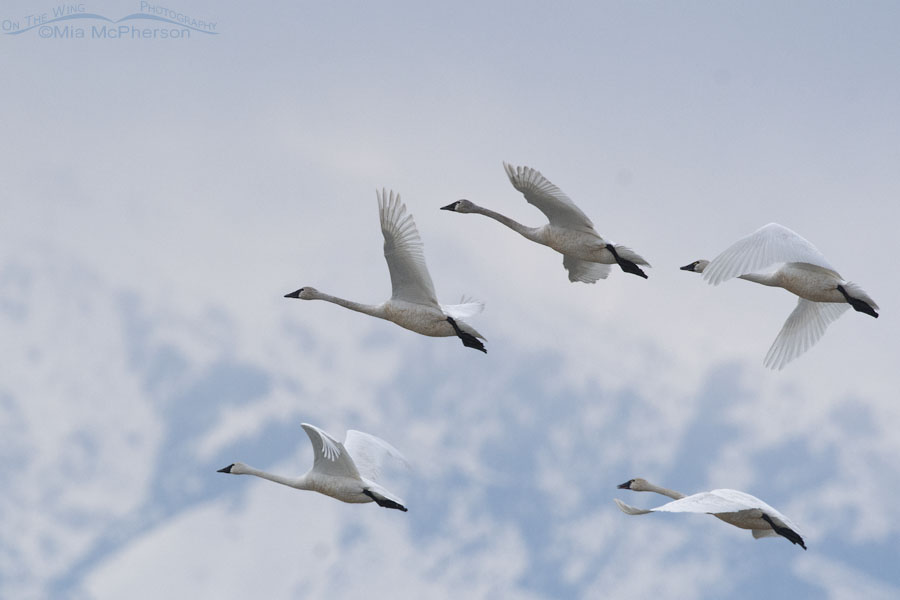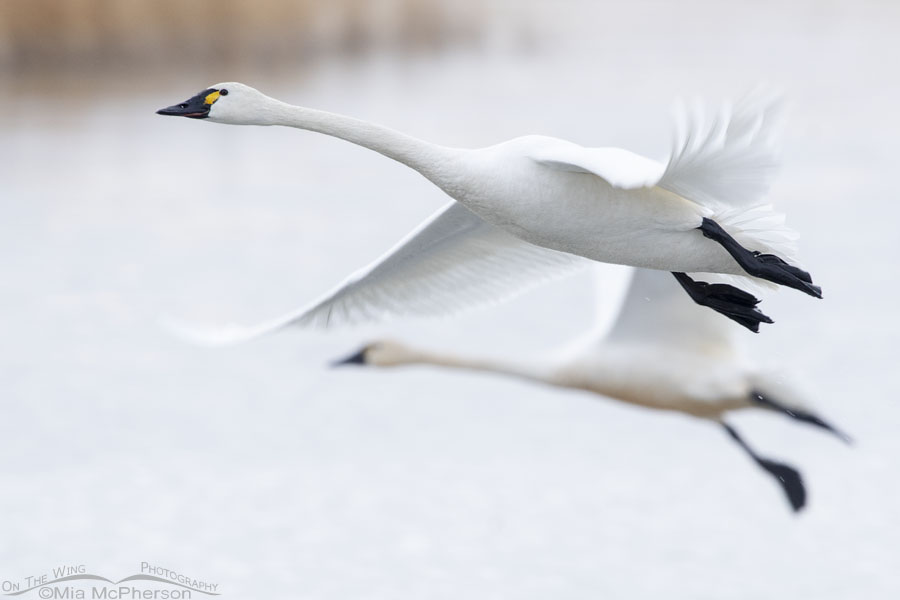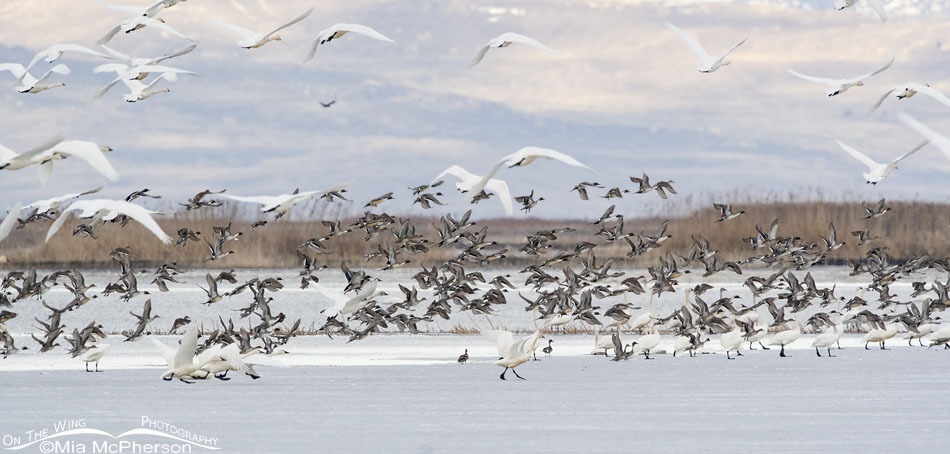 Tundra Swans in flight in low light – Nikon D500, f7.1, 1/2000, ISO 800, Nikkor 500mm VR with 1.4x TC, natural light
Tundra Swans in flight in low light – Nikon D500, f7.1, 1/2000, ISO 800, Nikkor 500mm VR with 1.4x TC, natural light
Yesterday morning it looked like there was going to be nice light at Bear River Migratory Bird Refuge not long after the sun rose over the snow-covered Wasatch Mountains. I checked the radar & satellite images on two different weather sites and I could see that the thin clouds that were there were moving south. I checked the hourly forecast for nearby Brigham City on both sites and it was supposed to be clear there until around 10 am.
Guess what? Those forecasts were wrong about the hourly forecast, it wasn’t clear, the clouds overhead were moving north not south and instead of bright sunlight I had low light conditions the whole time I was at the refuge. Not even ten miles to the north I could see beautiful light and the northern edge of the clouds that hung over the refuge and even though it was disappointing to be on the refuge in low light conditions I decided to do the best I could do with the light I had. Over the years I have found that I can create appealing and now and then even moody images when there are low light conditions so that is what I tried to do yesterday morning.
Our Tundra Swans won’t be at the refuge much longer and will soon be winging their way to their breeding grounds in the Arctic and I realize that my opportunities to photograph them before they leave are dwindling.
This first photograph shows five Tundra Swans that had lifted off from the frozen marsh in the low light with the snow-covered Wasatch Mountains in the background, snow was falling on those mountains as I took this image.
 Low light Tundra Swan lift off – Nikon D500, f7.1, 1/400, ISO 800, +1.0 EV, Nikkor 500mm VR with 1.4x TC, natural light
Low light Tundra Swan lift off – Nikon D500, f7.1, 1/400, ISO 800, +1.0 EV, Nikkor 500mm VR with 1.4x TC, natural light
There were some Tundra Swans that lifted off close enough to me that I was able to take frame filling images of them and even though the light was low I liked some of the resulting photos. While I would have preferred to be able to isolate single swans in those images sometimes that is nearly impossible to do when there are 50 to 75 or more swans lifting off at the same moment. The out of focus swan in this frame seems to add a sense of depth to the image and isn’t all that distracting to me, my eyes are drawn to the snow white plumage and the face of the swan I had focused on.
 Tundra Swans and Northern Pintails lifting off from the marsh – Nikon D500, f7.1, 1/1000, ISO 1000, +1.0 EV, Nikkor 500mm VR with 1.4x TC, natural light
Tundra Swans and Northern Pintails lifting off from the marsh – Nikon D500, f7.1, 1/1000, ISO 1000, +1.0 EV, Nikkor 500mm VR with 1.4x TC, natural light
Occasionally my images of birds have a painterly feel to them in low light situations and this image of Tundra Swans and Northern Pintails lifting off from the frozen marsh is one of them. Oh how I wish this image could include the whir of the wings of the swans and pintails and the calls of the swans that I heard when I took this photo because it was mesmerizing and I believe that if more people could see and hear what I see when I am in the field they could appreciate nature and our National Wildlife Refuges even more than they already do or perhaps awaken them to incredible facets of nature they have never experienced before.
Yes, I would have preferred better light when I was at the refuge yesterday but I’m okay with the light I had.
Life is good.
Mia
Click here to see more of my Tundra Swan photos plus facts and information about this species. Click here to see more of my Northern Pintail photos plus facts and information about this species.
Note: The Tundra Swans are visitors to northern Utah but the Northern Pintails are year round resident here. Aren’t we lucky?


Breathtaking photos!
The first image is my favorite. You managed to get various positions of the wings inflight. Thanks!
LOVE the group image! We are happy to see one Tundra a year or so and a few Northern Pintail, thank you, Mia, for sharing your wonderful images!
I think your low light shots are among some of your best. These spectacular images certainly support my point. Thanks Mia.
So beautiful, I hope to go up this weekend.
Yes you are lucky to have Northern Pintails year round. I would love to see them more often than once in a blue moon.
Both shots are stunning! Sometimes crappy light can be good!
Love the light and the mood it creates.
Sometimes low light produces great images, as it did for you. These are beautiful, and I love the mood
Love the shot of the pair!
Thanks Marie!